The History of Pineapples
Learn All About Pineapple, The Major Players & Tips Too!
Everywhere you go in Hawai’i, and quite possibly your home town, city or country, you’ll find an ingredient known the world over – pineapple. Today it’s a common flavor in many foods like beverages, cakes, sauces and marinades or main dishes like ham and pizza. But how did it become such a commonly found and used food item?
The history of the pineapple is thousands of years old and in the last 500 years it has spread from Central America to the Bahamas and on to Europe and North America. This beautiful, delicious fruit became, over hundreds of years, a symbol of wealth, hospitality and friendship.
The Mayas and Aztecs of Mexico were believed to be the first civilization to cultivate pineapple around 750 BC. However the plant originated in southern Brazil and Paraguay and became a valuable commodity to the Guarani Indians of South America who called it “nana” meaning “excellent fruit”. They carried it with them as they traded across Central America and the Caribbean.
Christopher Columbus encountered the fruit on the island of Guadeloupe in 1493, calling it “pina de Indes” meaning “pine of the indians” due to its resemblance to pinecones. He returned to Spain with the plants making them one of the first “new world” plants to be introduced to the European continent. Just over twenty years later the famous explorer Magellan is credited with discovering pineapples in Brazil. Imports of the fruit to England and beyond increased to the delight of European aristocrats.
From Spain the pineapple began its journey across the globe on multiple fronts. Throughout the 1500’s the Spaniards introduced pineapple plants to the African Continent starting in Zimbabwe and continuing on into the tropical climates of the Pacific cultivating them in the Philippines, Guam, and Hawaii. Meanwhile the Portuguese, also gathering the plant from their colonies in Brazil, transported it into India, Asia and the West Indies. Transporting pineapples was difficult and expensive but the allure of this delicious and beautiful fruit saw it’s popularity steadily grow.
The pineapples popularity as a symbol of wealth and hospitality continued to increase and by the mid 1600’s they were being successfully cultivated in specially designed hot houses throughout Europe.
Pride and Prestige
Soon these hot houses, called “pineries”, became symbols of wealth and prestige. King Charles II in England was presented with the first pineapple grown in England in 1677 and other monarchies and aristocrats in Europe began building pineries.
In 1723 Chelsea Gardens of London built a “pineapple stove”, that heated their hot house in order to cultivate the tropical plants for the needed 18 month growing cycle. In 1733 France’s King Louis XV was presented with a pineapple grown in a hot house pinery in the city of Versailles. Even Catherine The Great of Russia ate pineapples grown in pineries on her estates. Eventually pineapple rivalries broke out among the aristocratic families of Europe.
Interestingly the fruit was rarely eaten by most aristocrats, instead being used again and again as displays at dinner parties. They were carved into stone, wood and woven into carpets and drapes, making the pineapple a symbol of luxury.
Pineapple madness began to spread across Europe and eventually back to the New World. The American colonies revered the pineapple just as much as the Europeans did. Imported from the Caribbean, they were very expensive with a single pineapple costing as much as $8000 in today’s dollars. In 1751 George Washington, having tasted pineapples in Barbados, built a hot house at his Mt Vernon estate and grew pineapples. “Pineries” had become an engineering marvel of the times designed to provide constant temperature and light to grow the fruit in temperate zones throughout the world.
These heated glass greenhouses became a great way to show off one’s wealth with pineapples as well as oranges and mangos becoming popular crops. Pineapples also came into high demand by ship captains, including Captain Cook, as they were a great source of vitamins and could fend of scurvy. Pineapple patches could be found in harbors around the world and boosted their demand and exclusivity.
Christopher Cumo, author of “Foods that Changed History” writes that “pineapple was the fruit of colonialism” with the Spanish, Portuguese, French, British and Dutch who all sought to establish pineapple plantations in South America, Central America and the Caribbean.
There are stories of a Spanish shipwreck that may have brought the first pineapples to the Big Island around the mid 1520’s but the first record of pineapples being grown for commercial purposes in Hawai’i comes from a Spanish ship pilot named Don Francisco de Paula Marin. Marin arrived in Hawaii in 1794 and became a trusted advisor to Kamehameha the Great. Marin became an interpreter for the King and assisted in acquiring western weapons for Kamehameha’s attack on Oahu. For his service he was given land in Honolulu near Pearl Harbor. He acquired various seeds and plants from the Spanish in California and from English trading vessels.
In 1813 Marin introduced several crops he believed could thrive in the tropical and subtropical climates of Hawaii. He planted coffee, cotton, mangos, pineapples and grapes. By 1815 his wine grapes did so well in Honolulu that his wine became very popular. Today’s Vineyard Street in Honolulu was named after his vineyard.
When missionaries arrived from New England in 1820, pineapples were found growing both in the wild and in cultivated gardens. The pineapples allure gained momentum in Hawaii during the California gold rush of 1849. Between 1849 and 1851 some 20,000 pineapples were shipped from Kona to Honolulu and on to California. However spoilage was high on the long voyages to the mainland making for an expensive fruit with low profit margins. Small sporadic shipments of Hawaii pineapples continued until the turn of the century when the second industrial revolution made large scale pineapple production possible.
Hawaiians called the pineapple halakahiki, meaning “foreign hala” because it resembled the fruit of the hala tree. The hala tree’s fruit are not edible but the leaves were an important resource used to weave mats, hats and even canoe sails. Today visitors may think the hala tree looks like a pineapple tree, but don’t be fooled. Being in the bromeliad family of plants, pineapples grow low to the ground and often have sharp, spiny serrated leaves.
John Kidwell
John Kidwell, an English immigrant from London, established himself as a nurseryman and gardener in San Francisco in 1879 at the age of 29. Many of his best customers were from the Hawaiian Islands who bought flowers, plants and shrubs to import to the islands. They pointed out to Kidwell the advantages of establishing a nursery in Honolulu. Kidwell did just that, arriving on Oahu in 1882.
Kidwell arrived just as the Kingdom of Hawai’i had nearly completed a transformation from subsistence agriculture to a market economy. The land reforms of King Kamehameha III in the 1850’s allowed foreigners to buy large tracts of land to be used for commercial agriculture which was soon to be dominated by sugar cane plantations.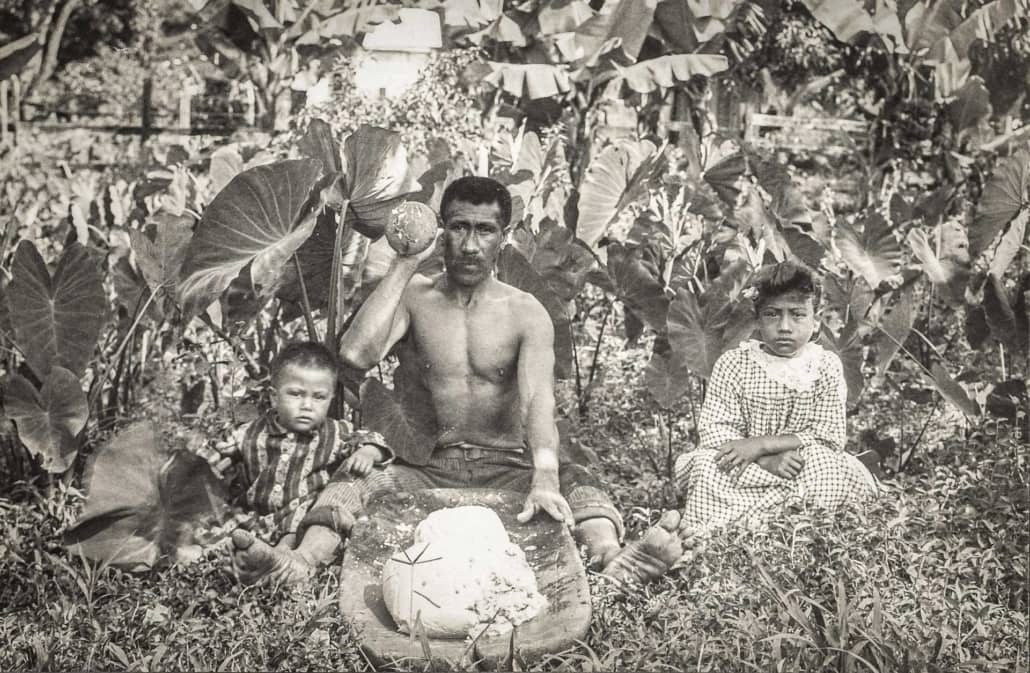
The expansion of the sugar economy was also accompanied by a demographic transformation. The native Hawaiian population had been steadily declining for decades, due mostly to introduced diseases which killed a large portion of the original population discovered by Captain Cook in 1778. An estimated 80% of native Hawaiians were gone by the early 1880’s. The population loss became counterbalanced by European and American immigrants and their descendants who established a large portion of the sugar industry. Workers were recruited from Asia to fill in the labor needs and the economic power of the planters grew. By 1875 the Kingdom of Hawaii was ruled by King David Kalakaua and the kingdom had its own constitutional government, legislature, courts and police. However, the economic power of the sugar planters meant the Hawaiian government was dependent upon them for its revenues.
Even though sugar was dominate in the islands there was a great demand for fresh Hawaiian pineapples in San Francisco. Pineapples from the Big Island of Hawai’i, known as “Wild Kailua” were picked green and sent to Honolulu to be shipped to the US. John Kidwell, familiar with hot house pineapples in London, realized these wild growing pineapples were of poor quality.
Kidwell and Big Island grower Charles Hansen brought pineapple shoots to Oahu in 1885 and planted 4 or 5 acres in the Manoa Valley. They grew larger here but still lacked the flavor Kidwell desired. He began researching horticultural periodicals and found a much praised variety in Florida called the Smooth Cayenne. He ordered a dozen plants that same year and another 1000 from Jamaica the following year. The crop was just over 60% successful but not quite to his liking, so he order 4 of every kind of pineapple known from London nurseries receiving 31 different species. However the Smooth Cayenne produced the best flavor and size.
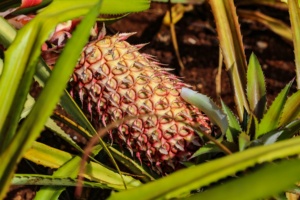
Wild Kailua Pineapple at Dole Plantation Oahu
Kidwell also developed the propagation of pineapple plants from stumps, cutting the tops off the fruit and replanting them. This however made the crownless fruit rot quicker in transport and in 1889 Kidwell began to delve into pineapple canning. His first cases of canned pineapples were shipped from his now 10 acre Manoa Valley plantation to San Francisco. However due to US tariffs on canned imports the endeavor lost money even though dealers considered the product superior.
John Kidwell
Even though sugar was dominate in the islands there was a great demand for fresh Hawaiian pineapples in San Francisco. Pineapples from the Big Island of Hawai’i were picked green and sent to Honolulu to be shipped to the US. Kidwell, familiar with hot house pineapples in London, realized these wild growing pineapples were of poor quality. He and Big Island grower Charles Hansen brought pineapple shoots to Oahu in 1885 and planted 4 or 5 acres in the Manoa Valley. They grew larger here but still lacked the flavor Kidwell desired.
He began researching horticultural periodicals and found a much praised variety in Florida called the Smooth Cayenne. He ordered a dozen plants that same year and another 1000 from Jamaica the following year. The crop was just over 60% successful but not quite to his liking, so he order 4 of every kind of pineapple known from London nurseries receiving 31 different species. However the Smooth Cayenne produced the best flavor and size.
Kidwell also developed the propagation of pineapple plants from stumps, cutting the tops off the fruit and replanting them. This however made the crownless fruit rotted quicker in transport and in 1889 Kidwell began to delve into pineapple canning. His first cases of canned pineapples were shipped from his now 10 acre Manoa Valley plantation to San Francisco. However due to US tariffs on canned imports the endeavor lost money even though dealers considered the product superior.
The Pineapple King
In 1901 James Drummond Dole, a graduate of Harvard Bussey Agricultural Institute began experimenting with several crops on his 64 acre homestead. He decided pineapples were more suited to the central Oahu land and formed the Dole Hawaiian Pineapple Company. Dole sold 125,000 cases of pineapples in 1905 and expands his operation by building Iwilei Cannery near Honolulu in 1907. By 1909 three major companies, Dole, Del Monte and Maui Land and Pineapple, were growing and processing pineapples the US market. In 1910 Dole hired engineer Henry Ginaca to build a pineapple coring and peeling machine. Until this invention pineapples were hand cut at a rate of 15 per minute. By 1913 Ginaca’s machines was processing 100 pineapples per minute and required only 3 to 5 workers. This revolutionized pineapple canning and these machines are still in use today.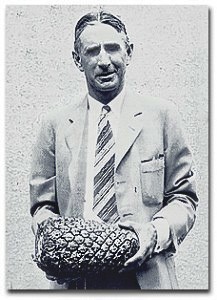
Dole began a marketing campaign in US national women’s magazines promoting pineapples and recipes. His marketing efforts became a huge success and soon he begins looking to expand his acreage.
With financial help from his family he purchases the island of Lana’i in 1922 for $1.1 million and begins planting around 20,000 acres, creating the largest pineapple plantation in the world and earning the islands nickname “The Pineapple Island”. Dole builds a harbor, lays out a small town for his workers and by 1930 was exporting 65,000 tons of pineapples per year. Hawai’i exported over nine million cases of pineapples from eight different canneries that same year. Hawaii was now supplying 80% of the world’s canned pineapples.
Harvard Square Library – Quotes of James Dole – “Pineapple growing created the necessity for a market, and in order to enlarge the market to the entire United States (and other countries) and to extend the marketing season throughout the entire year, a cannery seemed necessary. This meant that money had to be raised and a company started, and this necessitated more land, which had to be leased. I started my first pineapple plants in the spring of 1901, our company was incorporated in December of that year, and in the summer of 1903 we put up our first season’s pack of 1893 cases. In 1923 we packed 2,038,671 cases, or 43,497,828 cans. The period between has been one of repetitive cycles of more land, more pineapples, more cannery. Our plantings in 1923, if extended in a straight line, would have made a double row from New York to San Francisco.
Today Dole Pineapple Plantation sits on former Dole land near the north shore of Oahu. It has evolved from a small fruit stand in the 1950’s to one of Oahu’s top visitor attractions that includes train rides, pineapple gardens, an expansive gifts and snack shop and the world’s largest maze in the shape of a pineapple. Many visitors say the Dole Plantation is worth a stop just for the Dole Whip frozen dessert!
The eight different gardens are a walking tour aided by informational signs describing the gardens tropical fruits such as a half dozen different kinds of pineapples, various kinds of coffee plants and the colorful cacao pods used in the making of chocolate. A free app can be downloaded allowing you to hear about Hawaiian folklore, the north shore area, the various native and introduced plants and flowers as well as life on the plantation – all while you stroll through the gardens. The fish feeding pond is popular with the kiddos.
Prices
The train tour at Dole Plantation is a two mile long ride through the plantation. A fully animated 20 minute narration explains the history of pineapples in Hawaii and how James Drummond Dole built his agricultural empire and where the Dole Plantation stands today all while traveling through the beautiful scenery of Oahu’s north shore.
Prices
The dole Plantation features the world’s largest maze covering over three acres with paths traversing nearly 2 ½ miles, all in the shape of a pineapple. The maze is crafted with over 14,000 colorful native…? Hawaiian plants. Visitors can seek out eight secret stations leading to the heart of the maze. It is one of the few permanent botanical mazes in the US. Downloading the free Dole Plantation app allows you to automatically track your time and the stations you’ve found in the maze.
Prices
In the sprawling Dole Plantation gift shop you’ll find tons of things to enjoy. Aside from shipping a fresh pineapple back home there a plenty of gifts, treats and things to see and try. Demonstrations including pineapple cutting along with chocolate sampling produced from cocoa trees grown at nearby Waialua Estates. The Plantation Grille serves local plate lunch favorites as well as hot dogs and hamburgers. They’re famous pineapple ice cream, Dole Whip, is also not to be missed! Many reviews have said this stop is worth it just for the pineapple Whip!
In the sprawling Dole Plantation gift shop you’ll find tons of things to enjoy. Aside from shipping a fresh pineapple back home there a plenty of gifts, treats and things to see and try. Demonstrations including pineapple cutting along with chocolate sampling produced from cocoa trees grown at nearby Waialua Estates. The Plantation Grille serves local plate lunch favorites as well as hot dogs and hamburgers. They’re famous pineapple ice cream, Dole Whip, is also not to be missed! Many reviews have said this stop is worth it just for the pineapple Whip!
In 1932 Castle & Cooke, a large shipping and packing company that had operated in Hawaii since 1851, bought a 21% interest in Dole’s Hawaiian Pineapple Company. Castle & Cooke bought out the remainder of the company in 1960’s. From there the company continued to acquire produce companies throughout the 1970’s and 1980’s and renamed it “Dole Food Company in 1991. Today Dole operates plantations in Central and South America as well as in the Philippines, Thailand and southern Asia and is one of the worlds largest importers of bananas, pineapples, berries, salads, vegetables and juices. Dole also owns its own shipping line, Dole Ocean Cargo Express.
The Dole Plantation grew from a small fruit stand started in 1950 in the middle of James Dole’s original pineapple fields. In 1989 a plantation home was added which became a museum and historical archive of Doles achievements. Today the sprawling plantation is Oahu’s second most popular visitor attraction!
University of Hawai’i
The Pineapple Research Institute was started in the 1930 when the three major Hawaii pineapple growers, Dole, Del Monte and Maui Pineapple Company joined together to fund the research which attracted some of the best agriculturalist in the world. Renown pineapple geneticist J.L Collins, a former director of the Institute, stated in 1960 that: “The most complete collection of pineapple species and varieties (in the world) is the one maintained in Hawaii by the Pineapple Research Institute who’s collection constitutes a living herbarium of pineapple types.”
The Pineapple Island
The island of Lana’i sits almost dead center in the Hawaiian islands archipelago. It had always been sparsely inhabited even in ancient times but Kamehameha’s war of unification had nearly emptied the island. Sugar cane production was attempted by Chinese immigrants in the 1830’s but was short lived. In 1854 a group of Mormons from Utah were granted a lease by the Kingdom of Hawai’i on the island and in 1862 Walter M Gibson arrived to reorganize the settlement. He purchased the ahupua’a (ancient land division running from the mountains to the sea) of Palawai with church money but put the title in his own name. Despite being excommunicated from the church for this deed, he continued as leader of the colony and had acquired most of the island by the 1870’s for cattle ranching. Gibson went on to become the Minister of Foreign affairs for King David Kalakaua and eventually Prime Minister of the Kingdom of Hawaii in 1886.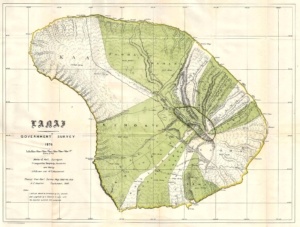
In 1890 Gibson’s daughter and son in law formed Maunalei Sugar Company on Lana’i but their business failed in 1901. Soon after Louisa Gay purchased a portion of the estate and by 1907 possessed most of the land on Lana’i. They planted 1200 acres of pineapples and by 1910 Honolulu newspapers had reported that the crop had been a success:
“…Several thousand pineapple tops have been sent to Lanai by the Lanai Company to develop its pineapple enterprise. The pineapple experiment on Lanai has been successful. The first ones raised weighed about eight and a half pounds each, but later ones were not so heavy, on account of the rows being too close. The industry will be developed on the island and made one of the principal crops.” (Hawaiian Gazette, November 22, 1910:8)
The crop did well but the island’s rugged roads and harbor made transporting fruit to market difficult. Gay would eventually sell the island to James Dole’s Hawaiian Pineapple Company in 1922 for $1.1 million – $29 million in today’s dollars.
Dole’s Lana’i plantation became the world’s largest pineapple plantation with over 16,000 acres in cultivation employing over 1000 Filipino, Japanese, Chinese, Portuguese, Korean and Puerto Rican immigrants. Agriculture began to decline and in 1961 Dole Food Company reformed into a new company named Castle & Cooke. Dole Food Company CEO David H Murdock bought out Castle & Cooke in 1985 and began planning on phasing out pineapple and developing the island as a tourist destination. The last harvest in 1992 ended a 70 year tradition of pineapples on Lana’i.
Today Lana’i is one of Hawaii’s most exclusive resort destinations. Luxury hotel Manele Bay offers 200 rooms and 26 suites near the harbor overlooking the stunning Hulopoe Beach Park. Inland is the the Koele Lodge at the cooler forested elevations near Lana’i City. Both resorts rank highly in the Top 20 Pacific Rim Resorts section of Conde Nast Traveler Readers Choice Awards. World class golf courses are laid out at both resorts.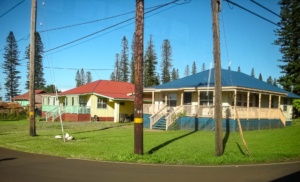
For the more budget minded Hotel Lana’i in Lana’i City is charming. It was built by James Dole in the 1920’s for executives of the Dole Plantation. Several B&B’s round out the options as well as camping at Hulopoe Beach Park near Manele Bay Hotel. The beach parks campground is wonderful with full showers and excellent snorkeling just off the beach.
David and Henry Baldwin purchased the land in West Maui above Honolua Bay in 1889 as a ranch. A year later they planted pineapple as an experimental crop. The fruit grew well here so they expanded the acreage over several decades and by 1909 the Baldwins formed the Maui Pineapple Company. Ranch manager David Thomas Fleming, a Scotsman, converted the Honolua Ranch into a pineapple plantation in 1912.
In 1920 a canning operation was created called Baldwin Packers (today’s Lahaina Cannery Shopping Center) for the Honolua pineapples and by 1924 was canning 4,500 cases per day!
By 1933 over 22,000 acres of pineapples were under production. The company’s crop, a hybrid called “Maui Gold”, became popular and the with pineapples cultivated on both sides of the island the company became the second largest pineapple producer in Hawai’i.
By 1962 Maui Pineapple Company had merged with Baldwin Packers and in 1969 the company merged again with J Walter Cameron, a 5th generation descendant of the Baldwin family, to become Maui Land & Pineapple Company (ML&P). Operations were moved to Kahului from Lahaina as roads were improved for trucking. The Lahaina cannery came into disrepair and was torn down and rebuilt into today Lahaina Cannery Shopping Mall in 1987.
In 1974 ML&P began it’s vision for a master planned resort community by forming the Kapalua Land Company. Throughout the 1970’s the resort developed luxury condominiums, tennis clubs, golf courses and a hotel while setting aside Honolua Bay and Mokule’ia Bay as Marine Life Conservations Districts. In 1988 ML&P dedicated over 8,000 acres including Pu’u Kukui, the summit of the west Maui Mountains, to conservation and the Pu’u Kukui Watershed Preserve remains the largest privately owned nature preserve in Hawai’i.
ML&P opened the Ritz-Carlton Hotel in 1992 and luxury homesites were developed throughout the 1990’s in the Kapalua area with the development of the Plantation Estates, Coconut Grove and Pineapple Hill Estates.
By 2009 the company ceased pineapple production after 97 years due to cheaper foreign labor markets. A group of Maui Pineapple Company executives and local investors formed the Hali’imaile Pineapple Company in 2010 and continue to grow fresh pineapples under the “Maui Gold” brand to Hawai’i and US markets. Today the company does pineapple tours in the town of Hali’imaile in upcountry Maui.
Production of Hawaiian canned pineapples peaked in 1957 and began a steady decline when foreign based plantations and canneries in the Philippines, Asia and Costa Rica began producing pineapples at labor costs around one-tenth that of Hawai’i. As canneries continued to close the industry shifted to the production of fresh pineapples for the local markets. Dole closed it’s cannery on Oahu in 1991, Del Monte ceased operations in 2008 and Maui Land & Pine closed it’s cannery in 2009. Today only two plantations remain. Dole Plantation on Oahu still produces fresh pineapples on a small scale as well as the Maui Gold Pineapple Company in upcountry Maui.
Fresh Hawaiian grown pineapples can be found on all the islands today and in some west coast markets. They are quite different from canned pineapples in that they have low acidity and are much sweeter. This is due to the work of the Pineapple Research Institute at the University of Hawai’i.
If sugar was the king of Hawai’i, than pineapple was it’s queen. In fact it can be said that pineapple and Hawai’i are still synonymous to this day. If you add pineapple to a pizza or burger it becomes a “Hawaiian” pizza or burger.
Back in the 1950’s and 60’s, if you were a Hawaiian going to school on the mainland, chances are your nickname was “pineapple”. That’s how ingrained the association with pineapples and Hawaii was and is. Hawai’i and pineapples became synonymous back in the 1920’s with the Dole Pineapple Company but the pineapples history in the islands spans over 100 years. Generations of local residents worked in the pineapple fields with many kids experiencing their first summer job while working in the pineapple canneries.
Various machines were developed over the years for the pineapple industry. The equipment simplified the planting, watering. Machines laid out mulch paper designating the planting rows. Large boom sprinklers watered and fertilized the crops. 62 foot long lighted conveyor booms were developed and fruit was harvested day and night.
Gangs of pineapple pickers would walk miles of pineapple rows picking fruit and tossing them on a conveyor belt sending them to large 7 ton bins on trucks. Workers covered themselves from head to toe to keep out the dust, pineapple bugs and protect against the sharp leaves. It was grueling work but generations of workers made a good living off of the pineapple industry in Hawai’i.
Back in the 1950’s and 60’s, if you were a Hawaiian going to school on the mainland, chances are your nickname was “pineapple”. That’s how ingrained the association with pineapples and Hawaii was and is. Hawai’i and pineapples became synonymous back in the 1920’s with the Dole Pineapple Company but the pineapple had already been in the islands for over 100 years.
James Dole resigned as director and chairman of the Hawaiian Pineapple Company. He continued to work on new things such as exchangers used for taking impurities out of such foods as sugar beet juices and apple juice. He and his wife Belle had raised five children. James Dole died in May of 1958 after a series of strokes and a heart attack. He is buried in Makawao facing Maui Pineapple Company’s pineapple fields. Next to him is his wife Belle who died in 1972.
James Dole has left his name which is still in use today. Next to “Kraft” the “Dole” brand is one of the best known name brands in the world and includes such products as bananas, vegetables, raisins, dates, almonds, pistachios, fresh kiwis, lemons and oranges
Hawaii’s pineapple production plateaued in the 1980’s and began to decline as plantations in the Philippines and Asia ramped up production with labor costs at a fraction of what Hawaii’s workers were paid. A booming tourism job market could provided many workers with high paying hotel jobs without the backbreaking toil of the pineapple fields.
Doles cannery ceased it’s Honolulu operations by 1991. By 2008 Del Monte ended it’s pineapple growing operations in Hawai’i and in 2009 the Maui Pineapple Company reduced its operations to supplying Maui Gold Pineapples only to local stores. Dole Plantation on Oahu now grows only about 0.1% of the worlds pineapple production.